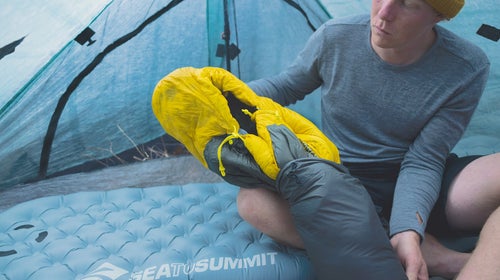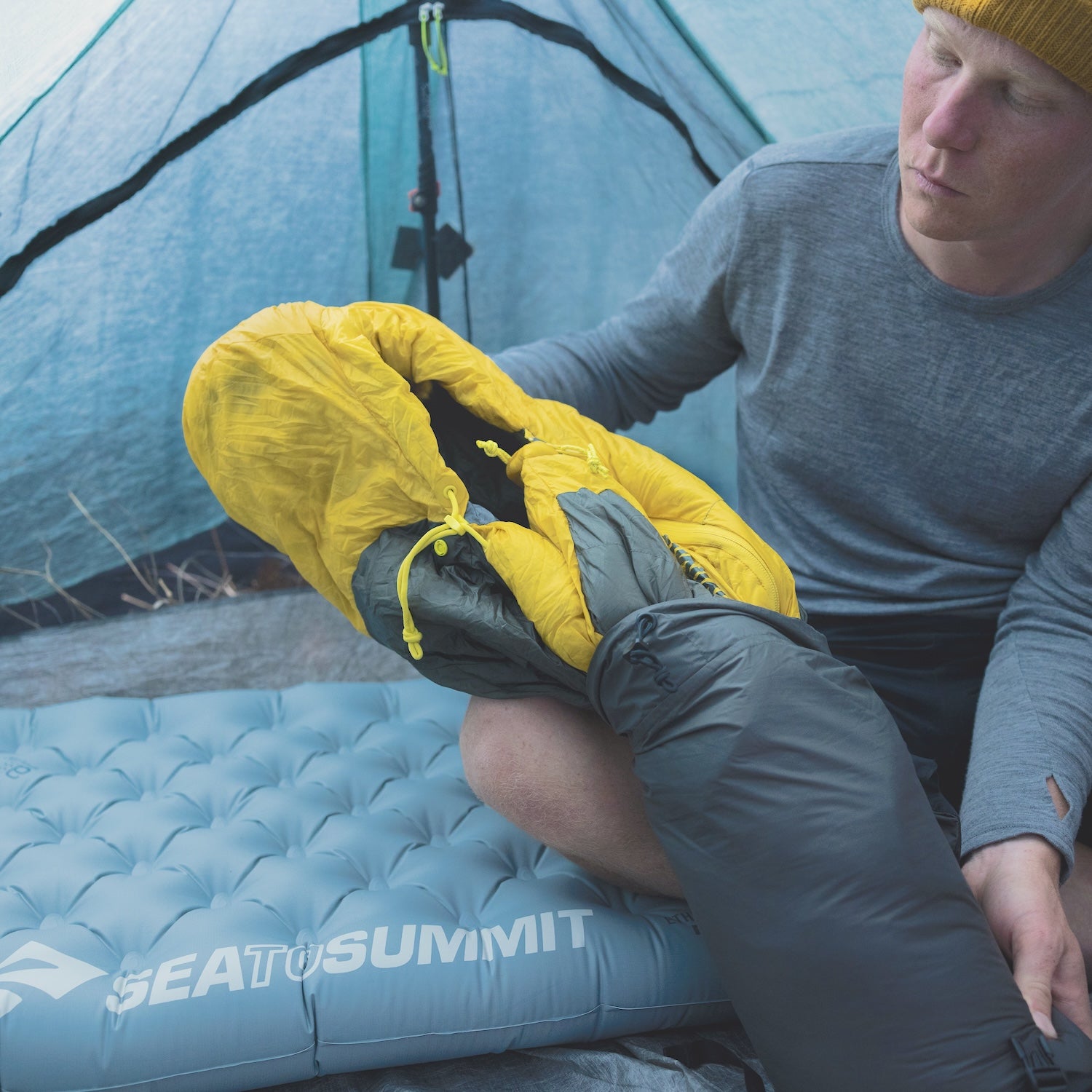Here’s how bedtime in camp goes in your mind: After a long day exploring some beautiful, wild place, you settle in around the campfire, favorite beverage in hand. Your eyes get droopy as you watch the sun set and stars begin to blink on. Finally, you snuggle into your cozy sleeping bag, yawning once before dropping off to sleep immediately for nine straight hours of deep, uninterrupted slumber.
Here’s how it actually goes: After a long day exploring some beautiful, wild place and watching the stars come out, you snuggle into your sleeping bag and…nothing. You toss and turn as the minutes tick by, trying to find a comfortable position. You stare at the tent ceiling, but sleep won’t come. Maybe you’re too hot, or worse: too cold, despite the rating of your sleeping bag. Maybe you can’t relax and stop listening for approaching bears. Or maybe you just can’t get comfortable on your pad. You finally drift into fitful sleep, but when morning comes too soon, you’re cold, more tired than ever, or dealing with a cramp in your neck.
Sound familiar? You’re not alone. But your camp nights don’t have to be this way. Two seasoned sleep experts are quick to offer key advice: Beyron Zecher, backpacker and nurse practitioner at St. John’s Health Sleep Disorder Center in Jackson, Wyoming; along with Barry Robertson, Sea to Summit’s Perth, Australia-based Minister of Education, who have your new gameplan on sleeping better outdoors.
Dial in Your Gear
Comfort plays a huge role in a good night’s sleep, so don’t rely on the absolute lightest or cheapest gear if you struggle for your Zs. Choose a stable, well-constructed sleeping pad that’s not too narrow or too short, and that offers enough insulation for the conditions ahead. Your sleeping bag should match your sleeping style: If you snooze sprawled out on your stomach, for example, your bag should be wide enough to accommodate. Make sure the bag is rated warm enough for the weather; on colder nights, wear thick base layers and a hat to bed. Consider a sleeping bag liner for a thermal boost to easily up the performance of your bag. And always pack a decent pillow. Bring one from home if you’re car camping and get a lightweight, inflatable one for backpacking.
Prep Your Campsite
The princess couldn’t sleep with a pea poking her under the mattress, and neither can you: Take the time to clear all twigs and stones from under your tent site before setting up your shelter. Make sure your site is as flat as possible; if it’s slightly tilted, sleep with your head on the uphill side. At higher altitudes, you’ll also need to factor wind protection. “If it isn’t windy at the moment,” Robertson adds of mountain camping, “it will be when the katabatic effect comes up early in the morning.”
Preserve a Bedtime Buffer
“Give yourself ample time to wind down,” Zecher says. “Avoid vigorous exercise three hours prior to bed because exercise can increase your body temperature and make you more alert.” That cutoff means finishing hiking well before bedtime so you have a few hours to set up camp, eat, and chill. Stop consuming caffeine at least four hours before bedtime. And stay away from screens, including tablets and phones, for two hours before you hit the hay. The lights emitted by screens can mess with your body’s melatonin production, Zecher explains. Darkness kicks off your body’s production of this hormone, which “tells your brain it’s time to get ready for bed.” Also skip alcohol: Though this common depressant may help you fall asleep, metabolizing it during the night will disrupt sleep quality and make night wakeups more likely.
Eat Up
Robertson revels in the simple joys of one-pot cooking, using bowls to keep multiple ingredients warm. It ultimately takes less time (especially at altitude) than freeze-dried fare, “plus there’s the primordial satisfaction of cooking your own food, then there’s the closure feeling you get as daylight fades.” Enjoy the magic of that caloric warmth, being well-fed and increasing blood flow as you digest and ready for sleep.
Change Clothes
Make this one change before you settle into your sleep system. Too cold to strip down to base layers? “It’s too cold to change out of damp base layers,” Robertson argues. “They’ll work as evaporative cooling in your sleeping bag. Strip everything off and put on dry base layers.”
Maintain Consistency
Stick to your regular bedtime routine as much as possible, whether that means sipping hot tea, reading in bed, or stretching. “Routines help the brain wind down through all these different cues that it’s time to go to bed,” Zecher says. That includes bedtime. If you usually go to bed at 11 p.m., stay up until 11 even if it gets dark at 8.
Get Up To Pee
“It won’t go away or get better,” Robertson says. Set yourself up so it’s not a big deal or a disruptive exit. When sharing a tent, he always makes a get-up-and-go kit (with TP, hand sanitizer, pocket trowel, plus extra headlamp), hung by the tent door.
Create a Peaceful Atmosphere
Environmental stimuli—from summer’s lingering sunsets to fellow campers rustling to twigs snapping in the woods—can disturb your precious sleep. Shut it all out with an eye mask (or bandanna or Buff) and/or ear plugs. Camp near a river or stream for natural sound-blocking white noise, or use an app on your phone for the same effect. Zecher suggests quieting the mind further through suppression exercises, like going through the alphabet backwards or naming all the state capitals in your head. Guiding yourself through imagery can have the same calming effect: “Move through a sequence of things,” Zecher says. “Walk the day’s hike from start to finish, noticing every bush and rock. It’s a form of meditation.”
Speaking of walking, Robertson has one other hack for controlling exterior noise: Go farther from other human beings. If you can work harder to create more distance, take the opportunity and appreciate solitude that will pay off come nightfall.
is an award-winning manufacturer of innovative, meticulously engineered, lightweight gear designed for camping, backpacking, water sports, and travel. Their ethos ‘to equip and inspire’ applies to adventures at every altitude, and this Western Australian brand is no stranger to some of the most remote places on this planet. Sea to Summit was established in 1990 and is currently distributed in over 73 countries, with offices in Australia, North America, Germany, and China.

